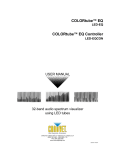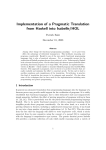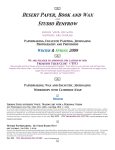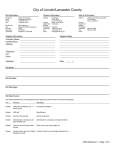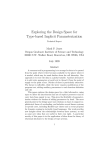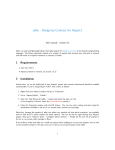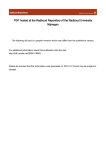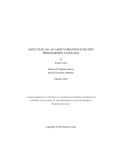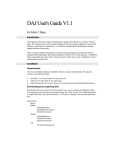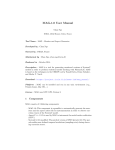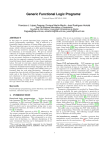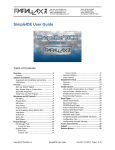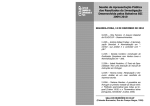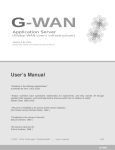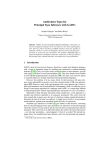Download Good Advice for Type-directed Programming - SEAS
Transcript
Good Advice for Type-directed Programming
Aspect-oriented Programming and Extensible Generic Functions
Geoffrey Washburn
Stephanie Weirich
University of Pennsylvania
{geoffw,sweirich}@cis.upenn.edu
ABSTRACT
Type-directed programming is an important idiom for software design. In type-directed programming the behavior of
programs is guided by the type structure of data. It makes
it possible to implement many sorts of operations, such as
serialization, traversals, and queries, only once and without
needing to continually revise their implementation as new
data types are defined.
Type-directed programming is the basis for recent research
into “scrapping” tedious boilerplate code that arises in functional programming with algebraic data types. This research
has primarily focused on writing type-directed functions that
are closed to extension. However, Lämmel and Peyton Jones
recently developed a technique for writing openly extensible
type-directed functions in Haskell by making clever use of
type classes. Unfortunately, this technique has a number of
limitations.
We present an alternate approach to writing openly extensible type-directed functions by using the aspect-oriented programming features provided by the language Aspectml. Our
solution not only avoids the limitations present in Lämmel
and Peyton Jones technique, but also allows type-directed
functions to be extended at any time with cases for types
that were not even known at compile-time. This capability
is critical to writing programs that make use of dynamic
loading or runtime type generativity.
1.
INTRODUCTION
Type-directed programming (tdp) is an invaluable idiom
for solving a wide class of programming problems. The
behavior of a type-directed function is guided by the type
structure of its arguments. Serialization, traversals, and
queries can all be implemented via tdp, with the benefit that
they need only be written once and will continue to work
even when new data types are added as the program evolves.
tdp has become a popular technique for eliminating boring “boilerplate” code that frequently arises in functional
programming with algebraic data types [11, 12, 8, 7]. The
goal in this research has been to develop easy-to-use libraries
Permission to make digital or hard copies of all or part of this work for
personal or classroom use is granted without fee provided that copies are
not made or distributed for profit or commercial advantage and that copies
bear this notice and the full citation on the first page. To copy otherwise, to
republish, to post on servers or to redistribute to lists, requires prior specific
permission and/or a fee.
Copyright 2006 ACM X-XXXXX-XX-X/XX/XX ...$5.00.
of type-directed combinators to “scrap” this boilerplate. For
example, Lämmel and Peyton Jones’s Haskell library provides a combinator called gmapQ that maps a query over
an arbitrary value’s children returning a list of the results.
Using gmapQ it becomes trivial to implement a type-directed
function, gsize, to compute the size of an arbitrary value.
gsize :: Data a => a -> Int
gsize x = 1 + sum (gmapQ gsize x)
However, this line of research focused on closed typedirected functions. Closed type-directed functions require
that all cases be defined in advance. Consequently, if the
programmer wanted gsize to behave in a specialized fashion
for one of their data types, they would need to edit the
definition of gmapQ.
The alternative is to provide open type-directed functions.
Lämmel and Peyton Jones developed a method for writing
openly extensible type-directed functions, via clever use of
Haskell type classes [13]. While their technique provides the
extensibility that was previously missing, there are caveats:
• It only allows open extension at compile-time, preventing the programmer from indexing functions by
dynamically created/loaded data types.
• It is not possible to openly extend type-directed functions with special cases for existential data types [14],
nested data types [3], or generalized algebraic data
types (gadts) [23]. Each of these sorts of data types
pose problems for constraint resolution.
• Each open type-directed function used introduces a
typing constraint into the environment, which for polymorphic functions is captures as part of the function’s
type. This makes it difficult to use these functions as
first-class values because their types may be too constrained to be used as arguments to other functions.
Because of these restrictions, Lämmel and Peyton Jones
retain their old tdp mechanism as a fallback when openly
extensible type-directed functions cannot be used. Providing
distinct mechanisms for open and closed tdp significantly
increases the complexity of tdp for the user. Additionally,
it may not be easy for a user unfamiliar with type inference
for type classes to understand why an extension to an open
type-directed function fails type-check.
We present an alternate approach to openly extensible
tdp using the aspect-oriented programming (aop) features
provided by the language Aspectml. Aspect-oriented programming languages allow programmers to specify what com-
putations to perform as well as when to perform them. For
example, aop in AspectJ [10] makes it easy to implement a
profiler that records statistics concerning the number of calls
to each method. The what in this example is the computation that does the recording and the when is the instant of
time just prior to execution of each method body. In aop
terminology, the specification of what to do is called advice
and the specification of when to do it is called a pointcut designator. A set of pointcut designators and advice organized
to perform a coherent task is called an aspect.
We, with with Daniel S. Dantas and David Walker, developed Aspectml as part of our research on extending aop to
functional languages with parametric polymorphism [5]. In
a language with parametric polymorphism, it is difficult to
write advice when a function may be used at many types.
It is also common to simultaneously advise functions with
disparate types. To address both of these issues, we found
runtime type analysis necessary for writing expressive advice.
However, we began writing more complex examples in
Aspectml, and we found that not only was runtime type
analysis necessary for expressive advice, but that advice
was necessary for expressive type-directed functions. In
particular, aspects enable openly extensible tdp. We use
advice to specify what the behavior of a specific type-directed
function should be for a newly defined type, or combination
of types, and when a type-directed function should use the
case provided for the new type.
Furthermore, we believe that our entirely dynamic mechanism for aop is critical to this expressiveness. Nearly all
other statically typed aop languages have a compile-time
step called “weaving” that fixes the when. In contrast, decisions concerning when are made entirely at runtime in
Aspectml. Consequently, not only does tdp in Aspectml
improve extensibility when writing programs, but also while
the programs are running. For example, it is possible to
safely patch Aspectml programs at runtime or manipulate
data types that did not exist at “compile-time”.
Our contributions in this paper include:
• examples of tdp in Aspectml.
• examples of how runtime advising is essential to the
expressiveness of type-directed functions.
• a comparison of our technique with other approaches
to openly extensible tdp.
In the next section, we introduce aop in Aspectml via
examples. In Section 3, we explain and show examples of tdp
in Aspectml. In Section 4, we show how aop in Aspectml
can be used to openly extend type-directed functions. In
Section 5, we provide a more detailed comparison with related
research. Finally, in Section 6, we discuss future directions
and summarize our results.
2.
THE ASPECTML LANGUAGE
We begin by introducing the general design of Aspectml.
Aspectml is a polymorphic functional, aspect-oriented language descended from the ml family of languages. The syntax
for a fragment of Aspectml is given Figure 1. It is most
similar to Standard ml [19], but occasionally uses OCaml or
Haskell syntax and conventions [15, 21].
We use over-bars to denote lists or sequences of syntactic
objects: x refers to a sequence x1 . . . xn , and xi stands for
k ::= *
| k1 -> k2
(polytypes)
s ::= <a[:k]> r
(ρ-types)
r ::= t
| s -> s
| pc pt
(pointcut type) pt ::= (<a[:k]> s1 ~> s2 )
(monotypes)
t ::= a
| T
| Unit
| String
| Int
| t1 -> t2
| (t1 , . . . ,tn )
| [t]
| t1 t2
(terms)
e ::= x
| C
| ()
| "..."
| i
| e1 e2
| let d in e end
| (fn p=>e)
| case e of p=>e
| typecase t of t=>e
| #f[:pt]#
| any
| (e1 , . . . ,en )
| [e1 , . . . ,en ]
| e:s
(patterns)
p ::= _
| x
| C
| ()
| "..."
| i
| p1 p2
| [p1 , . . . ,pn ]
| (p1 , . . . ,pn )
| p:s
(trigger time) tm ::= before
| after
| around
(kinds)
kind of types
function kinds
monotypes
higher-rank function
pointcut
type variables
type constructors
unit
strings
integers
functions
tuples
lists
type application
term variables
data constructors
unit
strings
integers
application
let declarations
abstraction
pattern matching
typecase
pointcut set
any poincut
tuples
lists
annotation
wildcard
variable binding
data constructors
unit
strings
integers
application
tuples
lists
annotation
(declarations)
d ::= val p = e
value binding
recursive functions
| fun f <a[:k]> (p)[: s] = e
| datatype T [: k] = C:s
data type def
| advice tm e1 <a[:k]> (p1 ,p1 ,p3 )[: s] = e2
advice def
| case-advice tm e1 (x:t1 ,p1 ,p2 )[:t2 ] = e2
Figure 1: AspectML syntax. Optional annotations are in
math brackets.
an arbitrary member of this sequence. We use a typewriter
font to indicate Aspectml programs or fragments. Italicized
text is used to denote meta-variables. We assume the usual
conventions for variable binding and α-equivalence of types
and terms.
The type structure of Aspectml has three layers: polytypes,
ρ-types, and monotypes. Unless, otherwise stated when we
refer to “types” in Aspectml we mean monotypes. Polytypes
are normally written <a:k> r where a:k is a list of binding
type variables with their kinds and r is a ρ-type. We often
abbreviate a:* as a. When a:k is empty, we abbreviate <> r
as r. This three-way partitioning of types is used as part of
Aspectml’s treatment of higher-rank polymorphism [22].
The category of ρ-types includes monotypes, higher-rank
polymorphic functions, and pc pt, the type of a pointcut,
which in turn binds a list of type variables in a pair of
polytypes. We explain pointcut types in more detail later.
In addition to type variables, a, simple base types like Unit,
String, Int, and function types, the monotypes includes
tuple and list types, (t1 , . . . ,tn ) and [t] respectively, type
application for higher-kinded monotypes, and type constructors T. Tuple types are actually syntactic sugar for an infinite
number of type constructors TUPLEn for n greater than two.
Type variables may only instantiated with monotypes; it is
not possible to construct a list of higher-rank polymorphic
functions, for example.
Type constructors can be defined using datatype declarations. The datatype declaration is essentially the same as in
ml and Haskell, with the exception of support for gadts [23],
and is used to define a new type constructor, T, via data
constructors. For example, lists in Aspectml are definable
by giving the types of the constructors.
datatype List = [] : <a> List a
| :: : <a> a -> List a -> List a
Note that, as in this example, it is always possible to elide the
kind annotation when defining a type constructor because
it can always be inferred. Furthermore, we require that
the programmer provide the complete types of the data
constructors because Aspectml provides gadts.
The term language of Aspectml include variables x, term
constructors C, unit (), integers i, strings " . . . ", tuples,
syntactic sugar for lists, anonymous functions, function application and let declarations. New recursive functions may
be defined in declarations. These functions may be polymorphic, and they may or may not be annotated with their
argument and result types. Furthermore, if the programmer
wishes to refer to type parameters within these annotations
of the body of the function, they must specify a binding
set of type variables <a:k>. When the type annotations
are omitted, Aspectml may infer them. However, inference
is Aspectml is limited to monotypes if no annotations are
provided. Aspectml does not yet support advice for curried
functions, so the syntax for recursive function definitions
only allows a single argument. However, curried functions
may still be written by using anonymous functions.
2.1
AOP in AspectML
To support aop, Aspectml provides pointcuts and advice.
Advice in Aspectml is second-class and includes two parts:
the body, which specifies what to do, and the pointcut designator, which specifies when to do it. A pointcut designator
has two parts, a trigger time, which may be before, after,
or around, and a pointcut proper, which is a set of function
names and an optional pointcut type annotation. The set of
function names may be written out verbatim as #f#, or, to
indicate all functions, the any pointcut might be used.
Informally, the pointcut type, (<a> s1 ~> s2 ), describes
the i/o behavior of a pointcut. In Aspectml, pointcuts are
sets of functions, and s1 and s2 approximate the domains
and ranges of those functions. For example, if there are
functions f and g with types String -> String and String
-> Unit respectively, the pointcut #f,g# has the pointcut
type pc (<a> String ~> a). Because their domains are
equal, the type String suffices. However, they have different
ranges, so we use a type variable to generalize them both.
Any approximation is a valid type for a pointcut, so it would
have also been fine to annotate #f,g# with the pointcut type
pc (<a b> a ~> b). This latter type is the most general
pointcut type, and can be the type for any pointcut, and is
the type of any pointcut.
The pointcut designator before #f# represents the point
in time immediately before executing a call to the function f.
Likewise after #f# represents the point in time immediately
after execution. The pointcut designator around #f# wraps
around the execution of a call to the function f—the advice
triggered by the pointcut controls whether the function call
actually executes or not.
The most basic kind of advice has the form:
advice tm e1 (p1 ,p2 ,p2 ) = e2
Here, tm e1 is the pointcut designator. When the pointcut
designator dictates that it is time to execute the advice,
the first pattern, p1 , is bound either to the argument (in
the case of before and around advice) or to the result of
function execution (in the case of after advice). The second
pattern, p2 , is matched against the current call stack. Stack
analysis is a novel feature of Aspectml, but it is orthogonal
to the expressiveness of tdp, so we do not discuss it in this
paper. Refer to our other papers for more information on
stack analysis [5]. The last pattern, p3 , is matched against
metadata describing the function that has been called, such
as its name or location in the source text.
Since advice exchanges data with the designated control
flow point, before and after advice must return a value
with the same type as the first pattern p1 . For around advice,
p1 has the type of the argument of the triggering function,
and the advice must return a value with the result type of
the triggering function.
A common use of aop to add tracing information to functions. These statements print out information when certain
functions are called or return. For example, we can advise
the program below to display messages before any function
is called and after the functions f and g return. The trace
of the program is shown on the right in comments.
(* code *)
fun f x = x + 1
fun g x = if x then f 1
else f 0
fun h _ = False
(*
(*
(*
(*
(*
(*
(*
Output trace
entering g
entering f
leaving f => 2
leaving g => 2
entering h
*)
*)
*)
*)
*)
*)
*)
(* advice *)
advice before any (arg, _, info) =
(print ("entering " ^ (getFunName info) ^ "\n");
arg)
advice after #f,g# (arg, _, info) =
(print ("leaving " ^ (getFunName info) ^
" => " ^ (intToString arg) ^ "\n");
arg)
val _ = h (g True)
Even though some of the functions in this example are
monomorphic, polymorphism is essential. Because the advice
can be triggered by any of these functions and they have
different types, the advice must be polymorphic. Moreover,
since the argument types of functions f and g have no type
structure in common, the argument arg of the before advice
must be completely abstract. On the other hand, the result
types of f and g are identical, so we can fix the type of arg
to be Int in the after advice.
In general, the type of the advice argument may be the
most specific polytype s such that all functions referenced in
the pointcut are instances of s. Inferring s is not a simple
unification problem; instead, it requires anti-unification [24].
Aspectml can often use anti-unification to compute this
type. It is decidable whether it is possible to reconstruct
the pointcut type via anti-unification, so the implementation
warns the user if they must provide the annotation.
Finally, we present an example of around advice. Again,
around advice wraps around the execution of a call to the
functions in its pointcut designator. The arg passed to the
advice is the argument that would have been passed to the
function had it been called. In the body of around advice,
the proceed function, when applied to a value, continues
that execution of the advised function with that value as the
new argument.
In the following example, a cache is installed “around” the
f function. First, a cache (fCache) is created for f with
the externally-defined cacheNew command. Then, around
advice is installed such that when the f function is called,
the argument to the function is used as a key in a cache
lookup (using the externally-defined cacheGet function). If
a corresponding entry is found in the cache, the entry is
returned as the result of the function. If the corresponding
entry is not found, a call to proceed is used to invoke the
original function. The result of this call is placed in the
cache (using the externally-defined cachePut function) and
is returned as the result of the f function.
val fCache : Ref List (Int,Int) = cacheNew ()
advice around #f# (arg, _, _) =
case cacheGet (fCache, arg)
| Some res => res
| None => let
val res = proceed arg
val _ = cachePut (fCache, arg, res)
in
res
end
We can transform this example into a general-purpose
cache inserter by wrapping the cache creation and around
advice code in a function that takes a first-class pointcut as
its argument as described below. Finally, we do not provide
their implementations here, but cacheGet and cachePut
functions are polymorphic functions that can be called on
caches with many types of keys. As such, the key comparisons
use a polymorphic equality function that relies on the runtime
type analysis described in Section 3.
One novel feature of Aspectml is the ability to use pointcuts as first-class values. This facility is extremely useful
for constructing generic libraries of profiling, tracing or access control advice that can be instantiated with whatever
pointcuts are useful for the application. For example, recall
the first example in Section 2 where we constructed a logger
for the f and g functions. We can instead construct an allpurpose logger that is passed the pointcut designators of the
functions we intend to log with the following code, assuming
the existence of a type-directed serializer toString.
fun startLogger (toLog:pc (<a b> a ~> b)) =
let
advice before toLog (arg, _, info) =
((print ("before " ^ (getFunName info) ^ ":" ^
(toString arg) ^ "\n")); arg)
advice after toLog (res, _, info) =
((print ("after " ^ (getFunName info) ^ ":" ^
(toString res) ^ "\n")); res)
in
()
end
3.
TDP IN ASPECTML
The tracing example, in Section 2.1, could only print the
name of the function called in the general case. If we would
also like to print the arguments as part of the tracing aspect
we must take advantage of Aspectml’s primitive for runtime
type analysis. For example, consider a revised tracing aspect
that can print the arguments to any function that accepts
integers or booleans:
advice before any <a>(arg : a, _, info) =
(print ("entering " ^ (getFunName info) ^
"with arg " ^
(typecase a
| Int => (int_to_string arg) ^ "\n"
| Bool =>
if arg then "True\n" else "False\n"
| _
=> "<unprintable>\n"));
arg)
This advice is polymorphic, and the argument type a is bound
by the annotation <a>. This ability to alter control-flow based
on the type of the argument means that polymorphism is
not parametric in Aspectml—programmers can analyze the
types of values at runtime. However, without this ability we
cannot implement this generalized tracing aspect and many
other similar examples.
Because dispatching on the type of the argument to advice
is such a common idiom, Aspectml provides syntactic sugar
called case-advice, that is triggered both by the pointcut
designator and the specific type of the argument. In the code
below, the first piece of advice is only triggered when the
function argument is an integer, the second piece of advice
is only triggered when the function argument is a boolean,
and the third piece of advice is triggered by any function
call. (All advice that is applicable to a program point is
triggered in inverse order from their definitions–newer advice
has higher precedence over older advice.)
case-advice before any (arg : Int, _, _) =
(print ("with arg " ^ (intToString arg) ^ "\n");
arg)
case-advice before any (arg : Bool, _, _) =
(print ("with arg " ^
(if arg then "True\n" else "False\n"));
arg)
advice before any (arg, _, info) =
(print ("entering " ^ (getFunName info) ^ "\n");
arg)
The code below and its trace demonstrates the execution
of the advice. Note that even though h’s argument is polymorphic, because h is called with an Int, the first advice
above triggers in addition to the third.
(* code *)
fun f x = x + 1
fun g x = if x then
f 1
else
f 0
fun h _ = False
val _ = h (g True)
3.1
(*
(*
(*
(*
(*
Output trace
*)
*)
entering g with arg True *)
entering f with arg 1
*)
entering h with arg 2
*)
Writing total type-directed functions
While very important for programming in the large, data
type definitions pose a problem for tdp in Aspectml: A
typecase expression can only have a finite number of cases,
yet the programmer may use datatype to define a new type
constructor at any time. For type-directed functions to be
generally useful in Aspectml it must be possible to write
total type-directed functions that cover all possible cases.
Furthermore, many type-directed functions are completely
defined by the type-structure of their arguments and providing cases for each of them would introduce significant
amounts of redundant code. Therefore, Aspectml requires
a mechanism for handling arbitrary type constructors and
their associated data constructors.
We will use the term atomic type to refer to those monotypes in Aspectml that are not defined via datatype and
cannot be decomposed into simpler types. For example, integers, strings, and functions are atomic types in Aspectml.
Tuple types and type constructors are not considered atomic.
To allow programmers to write total type-directed functions, we provides a primitive toSpine for converting arbitrary data constructor values to spine abstractions, as
introduced by Hinze, Löh, and Oliveira (HLO) [8, 7].
datatype Spine =
| SCons : <a> a -> Spine a
| SApp : <a b> Spine (b -> a) -> b -> Spine a
Spines can be thought of “exploded” representations of a
term constructor and the arguments that have been applied
to it. The term constructor SCons is used to hold the actual
constructor, and then a series of SApp constructors hold the
arguments applied to the constructor. For example, the
expression toSpine (1::2::3::[]) produces the spine
SApp (SApp (SCons (op ::)) 1) (2::3::[])
Note that this alternate representation is only one layer deep:
The two arguments of ::, 1 and 2::3::[], are unchanged.
The function toSpine must be a primitive in Aspectml.
If it were implement it the in terms of Aspectml like
fun toSpine <a>(x : a) : Option (Spine a) =
typecase a
| (a, b) =>
case x of (x, y) =>
Some (SApp(SApp Tuple2 x) y)
| (a, b, c) =>
case x of (x, y, z) =>
Some (SApp (SApp(SApp Tuple3 x) y) z)
| ...
an infinite number of cases would be necessary, as there are
an infinite number of tuple types. However, Writing the
inverse function, fromSpine, is straightforward.
fun fromSpine <a>(x : Spine a) : a =
case x
| SCons con => con
| SApp spine arg => (fromSpine spine) arg
val escape : String -> String
val toString : <a> a -> String
fun toString <a>(x : a) =
let
fun spineHelper <a>(x : Spine a) =
case x
| SCons c =>
(case (conToString c)
| Some s => "(" ^ s ^ ")"
| None => abort "impossible")
| SApp spine arg =>
"(" ^ (spineHelper spine) ^ " " ^
(toString arg) ^ ")"
in
typecase a
| Int => intToString x
| String => "\"" ^ (escape x) ^ "\""
| b -> c => "<fn>"
| _ => (case (toSpine x)
| Some spine =>
spineHelper spine
| None =>
abort "impossible")
end
Figure 2: toString in AspectML
Although the primitive toSpine function has type <a>
a -> Option (Spine a). and can therefore be used with
any input, it only returns a spine when provided with a
non-atomic type. This is because spines simply do not make
sense for atomic types; for example, λ-abstractions have no
data constructor that “builds” functions.
Finally, Aspectml provides primitive implementations of
equality and string conversion for integers, strings, and
unapplied data constructors. Unapplied constructors are
data constructors that have not been applied to any arguments. For example, :: versus 1::[]. The functions
eqCon and conToString have the somewhat unusual types:
<a> a -> Option Bool and <a> a -> Option String respectively. The reason they return Options is much like the
reason toSpine returns an Option—the polymorphic type
allows them to be applied to things other than unapplied
data constructors. Finally to address the problem that there
are infinitely many tuple type constructors we introduce a
primitive tupleLength of type <a> a -> Option Int that
if given an unapplied tuple type constructor will return an
Option containing its length. For all other values it will
return None.
Putting everything together, we can now write a typedirected pretty printer, toString, as shown in Figure 2.
If toString is applied to an integer it uses the primitive
intToString function to convert it to a string. If it is applied
to a string it calls the escape function to escape any special
characters and then wraps the string in quotes. For function
types, toString simple returns the constant string "<fn>"
because there is no way to inspect the structure of functions.
Finally, for all other types toString will attempt to convert
the value to a spine and then call spineHelper. Even though
we know that toSpine will always succeed, because the
typecase covers all atomic types, we must still perform the
check to make sure a Spine was actually constructed.
The function spineHelper walks down the length of the
spine and makes recursive calls to toString on the arguments and upon reaching the head converts the unapplied
val gmapT : <a> a -> (<b> b -> b) -> a
val gmapTspine : <a> Spine a ->
(<b> b -> b) -> Spine a
fun gmapT
(case
|
|
<a>(x:a) = fn (f:<b> b -> b) =>
(toSpine x)
Some y => fromSpine (gmapTspine y f)
None => x))
and gmapTspine <a>(x:Spine a) = fn (f:<b> b -> b) =>
case x
| SCons _ => x
| SApp spn arg =>
SApp (gmapTspine spn f) (f arg)
Figure 3: gmapT in AspectML
constructor to a string using conToString. As with toSpine,
it is again necessary to check the output of conToString
because the type system does not know that the argument
of SCons is guaranteed to be an unapplied constructor.
Furthermore, why did we choose to write spineHelper
rather than just adding a branch to the typecase expression
for the type constructor Spine, and then calling toString
recursively directly? There are two problems that arise with
such an implementation. Firstly, the behavior of toString
actually be incorrect in the instance that the argument is
a Spine. For example, toString (toSpine[1]) would produce the string "Cons 1 Nil" rather than "(SApp (SApp
(SCons Cons) 1) Nil)".
Secondly,such an implementation may only be given “wellformed” Spines, that is, spines that have unapplied data
constructors at their head. If we recall the definition of the
Spine data type
data Spine =
| SCons : <a> a -> Spine a
| SApp : <a b> Spine (b -> a) -> b -> Spine a
we see that there is nothing preventing a client from calling
toString on spines that do not have unapplied constructors
in them, like (SCons 5). The implementation in Figure 2
avoids this problem by converting all non-atomic types into a
spine before converting them to strings. Because toSpine is
guaranteed to construct well-formed Spines, it is guaranteed
to never fail.
3.2
Scrapping your boilerplate
It is now straightforward to use the tdp infrastructure
of Aspectml to implement the various combinators Lämmel
and Peyton Jones developed for generic programming.
In Figure 3 is an implementation of gmapT, a “single-layer”
generic mapping function. Given any value and a polymorphic function, it applies the function to any children the value
has, if any. It is implemented in terms of a helper function
for spines, gmapTspine. This helper is fairly straightforward.
Because the Spine data type makes the arguments to a constructor explicit via the SApp constructor, it only need walk
down the spine and apply the function f to each argument.
Finally, gmapT ties everything together by attempting to
convert the argument to a Spine. If toSpine fails, the
argument must be atomic and has no children to map over.
If toSpine succeeds, gmapTspine is applied to the spine and
fromSpine is used to convert back to the original type.
val == : <a> a -> a -> Bool
fun == <a>(x:a) = fn (y:a) =>
let
fun spineHelper <a>(x:Spine a, y:Spine a) =
case (x, y)
| (SCons c1, SCons c2) =>
(case (eqCon c1 c2)
| Some z => z
| None => abort "impossible")
| (SApp sp1 arg1, SApp sp2 arg2) =>
(case (cast sp2, cast arg2)
| (Some sp2', Some arg2') =>
(sp1 == sp2') andalso (arg1 == arg2')
| _ => False))
in
typecase a
| Int => eqint x y
| String => eqString x y
| _ =>
(case (toSpine x, toSpine y)
| (Some x', Some y') => spineHelper (x', y')
| (None, None) => abort "equality undefined")
end
Figure 4: Polymorphic structural equality in AspectML
To effectively use gmapT we need a way to construct a polymorphic function of type <b> b -> b that is not either the
identity or the diverging function. Lämmel and Peyton Jones
initially implemented this using a combinator extT that lifts
a monomorphic function of type t -> t, for any type t,
to be <b> b -> b. They do this using a primitive casting
operation, but it is simple to implement in Aspectml.
fun extT <a>(f:a -> a) = fn <b> (x:b) =>
typecase a of b => f x
| _ => x
It is then straightforward to use gmapT to write a generic
traversal combinator
fun everywhere <a>(f:<b> b -> b) = fn (x:a) =>
f (gmapT x (everywhere f))
While very useful, toString, gmapT and everywhere may
only traverse over a single value at a time. Many typedirected functions need to be able to operate on multiple
values simultaneously. The generic structural equality, shown
in Figure 4, is the prototypical example. For atomic values
that are integers or strings, the primitive equality functions
are used. However, if both values have a spine representation,
the spines are compared with the function spineHelper. If
both spines are unapplied data constructors, spineHelper
uses the primitive equality, eqCon. Otherwise, if both spines
are application spines, the arguments and remainder of the
spines are compared recursively.
Because spines are existential data types, it is necessary
to use a cast in the case for SApp in order to ensure that
the arguments and constituent spines have the same types.
Otherwise it would not be possible to call == or spineHelper
recursively, as they both require two arguments of the same
type. Writing cast is trivial in Aspectml, because it is
possible to use abstracted types within type patterns
datatype Queue = Q : <a> List a -> List a -> Queue a
datatype Exists = Ex : <a> a -> Exists
val emptyQueue : <a> Queue a
val emptyQueue = Q [] []
val pickle : <a> a -> String
val unpickle : String -> Exists
val enqueue : <a> a -> Queue a -> Queue a
fun enqueue e = fn (Q l1 l2) => Q l1 (e::l2)
val
val
val
val
val dequeue : <a> Queue a -> Option (a, Queue a)
fun dequeue q =
case q
| Q [] [] => None
| Q [] l2 => dequeue (Q (rev l2) [])
| Q (h::t) l2 => Some (h, Q t l2)
Figure 5: Amortized constant time functional queues
fun cast <a b>(arg : a) : Option b =
typecase a of b => Some arg
| _ => None
So far we have only transliterated some standard examples
of tdp into Aspectml. We believe that our realization of
these functions is quite elegant, but the most significant
benefit comes from the dynamic open extension allowed by
Aspectml. We will examine this capability in the next.
4.
OPEN EXTENSIBILITY
By default, toString, gmapT, everywhere, and == work
with all Aspectml monotypes, but the programmer has no
control over the behavior for specific types. This a problem
because the programmer might define a new data type for
which the default behavior is incorrect. This problem is
easily solved in Aspectml using advice.
Starting out simple, while toString from Figure 2 can produce string representation for all types, its string representations of tuples is not what we would expect. The application
toString (1,True) will generate the string "((Tuple2 1)
True)". We can improve the output by writing advice for
toString to provide a specialized case for tuples.
advice around #toString# <a>(x : a, _, _) =
let
fun helper <a>(spine : Spine a) =
case spine
| SCons _ => ""
| SApp spine arg =>
(helper spine) ^ ", " ^ (toString arg)
in
case (tupleLength x)
| Some i =>
(case (toSpine x)
| Some spine => "(" ^ (helper spine) ^ ")"
| None => abort "impossible"
| None => proceed x
end
This advice triggers on any invocation of toString, and
checks whether the argument is a tuple using the tupleLength
primitive we discussed in Section 3.1. If it is not a tuple,
it uses proceed to return control to the toString function.
Otherwise, it converts the tuple to a Spine and then walks
down the spine producing a comma separated string representation.
While it is nice that we can use advice to specialize the
behavior of toString, the modification was simply for aes-
openFile : String -> Handle
writeFile : Handle -> String -> Unit
readFile : Handle -> String
closeFile : Handle -> Unit
Figure 6: Simple primitives for dynamic loading
thetic purposes. There are cases where the default behavior
of a type-directed function is incorrect. Say the programmer
defines a new data type and the default traversal behavior
provided by everywhere is not correct; traversal orders is
especially relevant in the presence of effects the traversal order could be important. For example, consider the common
functional implementation of queues via two lists in Figure 5.
Elements are dequeued from the first list and enqueued to
the second; if the dequeue list becomes empty the enqueue
list is reversed to become the new dequeue list. By default,
everywhere will traverse the dequeue list in the expected
head to tail order (fifo) but the default traversal will walk
over the enqueue list in the reverse of what a user might
expect.
One solution would be for the author of Queue to edit
everywhere or gmapT to include a special case for queues.
But, this solution is undesirable because their source code
might not be available, and continually adding special cases
would clutter them with orthogonal concerns.
If the author of the Queue data type knows that everywhere
is implemented in terms of gmapT, can simply write the following advice for gmapT to ensure that the elements are
traversed in fifo order.
case-advice around #gmapT# (x:Queue a,_,_) =
fn (f:<b> b -> b) =>
case x
| Q l1 l2 => Q (map f (l1 @ (rev l2))) []
This case-advice intercepts a call to gmapT when the first
argument is type Queue a for any a, otherwise gmapT is
executed.
The author or the Queue data type will encounter another
problem when using the type-directed structural equality
function described in Section 3.2, because it distinguishes
between too many values. For example, == does not equate
the queues Q [1] [] and Q [] [1] even those both of these
queues are extensionally equivalent. In fact, this is an example of how structural equality breaks representation independence.
Fortunately it is again quite simple to use advice to extend
== so that it correctly compares Queues.
case-advice around # == # (x:Queue a, _, _) =
(fn (y : Queue a) =>
case (x, y)
| (Q l1 l2, Q l3 l4) =>
(l1 @ (rev l2)) == (l3 @ (rev l4))
This advice triggers when == is called on values of type
Queue a and converts the constitutes lists to a canonical
form before comparing them.
The examples of open extension we have shown so far
datatype Extension = Ext : Exists ->
(Unit -> Unit) ->
Extension
datatype Exists = Ex : <a> a -> Exists
val pickle : <a> a -> String
val unpickle : String -> Exists
val
val
val
val
openFile : String -> Handle
writeFile : Handle -> String -> Unit
readFile : Handle -> String
closeFile : Handle -> Unit
advice after #unpickle# (ex : Exists, _, _) =
case ex
| Ex <a> x =>
(typecase a
| Extension =>
(case x of (Ext ex f) => (f (); ex)
| _ => ex)
Figure 7: Extended dynamic loading
are quite useful, but are essentially the same as what is
possible using Lämmel and Peyton Jone’s technique, modulo
its restrictions. Our approach however, extends to uses
that are simply not possible with static approaches. For
example, consider programming an extension to Aspectml
to support dynamic loading, using the primitives defined in
Figure 6. The functions openFile, writeFile, readFile,
and closeFile are straightforward functions for file i/o.
The two primitives pickle and unpickle are a bit more
complicated. The pickle primitive is similar to the function
toString we defined, but includes support for meaningful
serialization of functions. Its inverse pickle returns an
existential datatype, Exists. This is because we cannot
know the type of the value that will be produced in advance.
However, thanks to tdp it is possible to still do useful things
with the data, even if we have no idea what it might be. For
example, our type-directed functions gmapT, everywhere,
and == can still be used on the value the existential package
is hiding.
It is even possible for a program to manipulate data types
that were not defined when it was compiled. Specifically, we
might have two separate programs each with some data types
unique to them. For example, imagine one of our programs
used the queues described in Figure 5, but another did not.
This first program would be able to pickle a queue, write it
to a file, and then the second program could then read the
queue out of the file and manipulate it as it would any other
existentially packaged value.
However, this second host will encounter the exact same
problems we discussed earlier with gmapT and == behaving
incorrectly on functional queues. If it was only possible to
extend type-directed functions at compile-time there would
be nothing that could be done. However, because we might
use advice to dynamically extend type-directed functions,
we opt to package data written to disk with the necessary
extensions. We show a fairly naı̈ve implementation of this in
Figures 7 and 8.
In Figure 7, we extended the dynamic loading primitives
with a notion of “extension”. The new data type Extension
packages up an existential along with a function from Unit ->
val myQueue = enqueue 2 (enqueue 1 emptyQueue)
val f =
(fn () =>
let
case-advice around #toString# (x:Queue a,_,_) =
case x
| Q l1 l2 =>
"[|" ^
concat " " (map toString (l1 @ (rev l2)) ^
"|]"
case-advice around #gmapT# (x:Queue a,_,_) =
fn (f:<b> b -> b) =>
case x
| Q l1 l2 => Q (map f (l1 @ (rev l2))) []
case-advice around # == # (x:Queue a,_,_) =
fn (y : Queue a) =>
case (x, y)
| (Q l1 l2, Q l3 l4) =>
(l1 @ (rev l2)) == (l3 @ (rev l4))
in
()
end)
val file = openFile "testing.data"
val () = writeFile file
(pickle (Extension (Ex myQueue) f))
val () = closeFile file
Figure 8: Program compiled with functional queues
Unit that can be used to perform any necessary configuration
required for the packaged value. We then provide advice for
the unpickle primitive to checks whether it has created an
Extension value. If so, it invokes the function contained in
the Extension and returns included the existential package
as the result.
Our first program, that was compiled with functional
queues can now store them to disk as shown in Figure 8.
Here, it creates an configuration function that installs the
relevant extensions to toString, gmapT, and == for functional
queues. It then packages the function with a queue and writes
it to disk. Now any other program built with the “extensible”
version of the dynamic loading primitives in Figure 7 can
read the queue from the disk, and at the same time receive
appropriate advice for manipulating the data in a generic
fashion. For example, it can call toString on the value it
obtains from the file testing.data and obtain "(Ex [|1
2|])".
Furthermore, data type definitions in Aspectml are generative, so that every time they are evaluated a new distinct
data type is created. Therefore, type-directed functions will
in practice encounter types that were not defined at compiletime anywhere. In the following example, every time nonce
is called not only does it give a distinct value, but a distinct
type!
val getTime : Unit -> Time
val nonce : Unit -> Exists
fun nonce () =
let
datatype Nonce = Nonce : Time -> Nonce
in
Ex (Nonce (getTime ())
end
Without the dynamic extensibility provided by aspects there
would be no way to handle these kinds of examples.
5.
RELATED-WORK
In this section we will examine the wide spectrum of research that this paper is built upon.
5.1
Extensible type-directed programming
Scrapping your boilerplate with class. Our examples in
Sections 3 and 4 were adapted from the work of Lämmel and
Peyton Jones on “scrapping your boilerplate” [11, 12, 13]. In
their latest paper, Lämmel and Peyton Jones have attempted
to address the problem of providing openly extensible typedirected functions. This is done by associating each typedirected function with a type class. However, this technique
has many limitations. Most importantly, the Haskell type
class mechanism requires that all instances for these classes
be defined at compile-time. Consequently, it is impossible
to use their library with types that are not known until
runtime. This is necessary for any applications that make
significant use of dynamic loading or generative types, such
as the examples in the previous section.
The second major limitation of their technique is that
it is not possible to write openly extensible type-directed
functions that have specialized behavior on several significant
classes of data types: existential data types, nested data
types, and gadts. It is not possible to write open typedirected functions for existential data types because their use
of the type class mechanism. Consider the following example
where we attempt to define a specialized case for Size, an
open type-directed function to generically compute the size
of a value.
class Data Size a => Size a where
gsize :: a -> Int
data Exists :: * where Ex :: a -> Exists
instance Size Exists where
-- Does not type check
gsize (Ex (ex :: b)) = 1 + gsize ex
Here, in order to define an instance of Size for Exists, we
need to call gsize on the existentially packaged value ex.
However, calling gsize requires that there exist an instance
of Size for type b. However, because b could be anything
there is no way of determining whether such an instance
exists. The only solution is to require that the Exists data
type package the necessary type class dictionary itself.
data Exists :: * where
Ex :: Size a => a -> Exists
instance Size Exists where
-- Type checks
gsize (Ex (ex :: b)) = 1 + gsize ex
However, this is simply not scalable as every time we would
like to use an open type-directed function on values of type
Exists it will be necessary to add another constraint to the
data type definition.
Nested data types, such as Okasaki’s square matrices [20],
cause other difficulties with type class constraints.
data Sq a = Zero a | Succ Sq (a, a)
In order to solve type-classes constraints for Lämmel and
Peyton Jones’s implementation, a form of coinductive constraint solving is necessary. Therefore, a solver attempting
determine whether the type class constraint for Size [a] is
satisfiable will go through a constraint back-chaining process
that looks like the following.
Size [a]
↓
Size [a], Data SizeD [a]
↓
Size [a], Data SizeD [a], Sat (SizeD [a])
First, Size [a] requires the instance Data SizeD [a]. And
Data SizeD [a] needs Sat (SizeD [a]). Finally, because
Size [a] implies the existence of Sat (SizeD [a]) and at
this point the solver reaches as fixed-point.
With nested data types a fixed-point can never be reached.
For example, an instance for Size (Sq a) will require an instance of Data SizeD (Sq a) which needs both Sat (SizeD
a) and Sat (SizeD (Sq (a,a))). While Sat (SizeD (Sq
(a, a)) can be obtained from Size (Sq (a, a)), it in
turn needs Data SizeD (Sq (a,a)) which in requires Sat
(SizeD (Sq ((a,a), (a,a)))), and so forth ad nauseam.
A similar problem arises with gadts. Consider the following contrived gadt.
datatype Foo :: * -> * where
Bar :: a -> Foo a
Qux :: Foo Int -> Foo Bool
instance Size a => Size (Foo a) where
gsize (Bar x) = gsize x
gsize (Qux fi) = 1 + (gsize fi)
Here, attempting to call gsize on fi will require an instance
of Size (Foo Int) which will require an instance of Data
SizeD (Foo Int) which will in turn need the instance Sat
(SizeD (Foo Int)). However, Sat (SizeD (Foo Int))
would require an instance Size (Foo Int) to be derivable,
but there is no such instance.
Finally, because each open type-directed function used
introduces a constraint into a function’s type it becomes
difficult to use them as first-class functions. This is because
they may become more constrained than other functions are
expecting their arguments to be. For example,
shrink :: Shrink a => a -> [a]
shrinkList :: (Eq a, Shrink a) => [a] -> [a]
shrinkList xs = nub (concat (map shrink xs))
gmapQ :: Data ctx a => Proxy ctx ->
(forall b. Data ctx b => b -> r) ->
a -> [r]
-- Ill-typed
shrinkTwice x = gmapQ shrinkProxy
(shrinkList . shrink) x
Here shrinkTwice is ill-typed because gmapQ is expecting
a polymorphic function with the constraint Data ctx b
for some ctx and some b. However, the composition of
shrinkList and shrink has the constraint (Eq a, Shrink
a) which resolves to (Eq a, Data Shrink a) which is too
constrained by the need for the Eq type class to be a valid
argument.
This problem with constraints can be allievated by either making shrinkList an openly extensible type-directed
function or by introducing new dummy type classes that
encapsulate constraints. The former leads to large amounts
of boilerplate for otherwise simple helper functions and the
latter leads to a combinatorial explosion as the number of
type-directed functions grow.
Scrapping your boilerplate with spines. Our use of spines
to implement type-directed functions was heavily influenced
by the closely related work by Hinze, Löh, and Oliveira on understanding Lämmel and Peyton Jones’s techniques in terms
of spines. In their work, they opt to implement toSpine
directly using type representations built from gadts. They
assume the existence of some mechanical method of producing all the necessary representations and cases for toSpine.
However, in order to provide open extension, they use type
classes in a fashion inspired by Lämmel and Peyton Jones.
Therefore, their approach to open extension has many of the
same problems with type-classes.
In their more recent work, Hinze and Löh have shown how
to extend spines so that it is possible to implement typedirected functions that can not only process arbitrary data
types, but built values of arbitrary type. Additionally, they
show how to perform type-directed operations on higherkinds using what they call lifted spines. Aspectml does not
presently have support for writing type-directed functions
that construct arbitrary data types. We could easily adapt
the modifications to spines that Hinze and Löh developed, but
we will most likely pursue an approach based upon Weirich’s
concurrent research [32]. It would be straightforward to
extend Aspectml with support for lifted spines, but we think
it would be better for us to focus on developing a general
solution for writing functions with polykinded types [6].
A core calculus for open and closed TDP. Along with
Dimitrios Vytiniotis, we developed a core calculus, λL , that
could be used to implement type-directed functions that
could be either closed or open to extension [27]. While it
was possible to extend type-directed functions in λL , the
programmer must manage the extensions herself, and manually close off the recursion before the functions could be
used. However, as λL was designed as a core calculus rather
than a high-level programming language, it is not expected
to be easy to write software in λL .
A novelty of λL is its use of label-sets to statically ensure
that a type-directed function was never given an argument
for which it lacked a case. However, label-sets are very heavyweight and lack sufficient precision to describe whether some
inputs are acceptable. In Aspectml, the programmer must
rely on the initial implementation of a type-directed function
covers all the necessary types. Lämmel and Peyton Jones
use of type classes does not have this problem as constraint
solving can be relied upon to know that the input will have
instances for all the appropriate type classes. However, checking that a type-directed function covers all cases statically,
requires knowing all types that may be used statically.
5.2
Generic programming
The research on Generic Haskell [17] is related to our
work on Aspectml in many ways. However, Generic Haskell
has a number of limitations in comparison to Aspectml.
Firstly, in Generic Haskell all uses of type information are
resolved at compile-time, making it impossible to extend
to tdp with types that are created at runtime or loaded
dynamically. Secondly, Generic Haskell does not provide any
direct mechanism for open extension. The latest version of
Generic Haskell has added syntactic sugar easily extend a
type-directed function with new cases. However, these new
cases do not change the behavior of the original function, as
advice does.
Achten and Hinze examined an extension to the Clean
language [1] to allowing dynamic types and generic programming to interact cleanly [2]. This extension is quite flexible,
even providing polykinded types. However, the generic functions in this language extension did not provide any kind of
open extension. Cheney and Hinze developed a library with
very similar capabilities in Haskell in terms of type representations [4]. However, it is not possible to provide special
cases for user defined types in their library without defining
new type representations, and modifying the infrastructure.
5.3
Aspect-oriented programming
There has been an increasing amount of research into aop
in the presence of parametric polymorphism. Our language,
Aspectml, directly builds upon the framework proposed by
Walker, Zdancewic, and Ligatti [28], but extends it with
polymorphic versions of functions, labels, label sets, stacks,
pattern matching, advice and the auxiliary mechanisms to
define the meaning of each of these constructs. We also
define “around” advice and a novel type inference algorithm
that is conservative over Hindley-Milner inference, which
were missing from WZL’s work.
Concurrently with the development of Aspectml, Masuhara, Tatsuzawa, and Yonezawa [18] developed an aspectoriented version of core OCaml they call Aspectual Caml.
Their implementation effort is impressive and deals with
several features we have not considered, including curried
functions and extensible data types. There are similarities
between Aspectml and Aspectual Caml, but there are also
many differences: Pointcut designators in Aspectml can only
reference names that are in scope, Aspectual Caml does not
check pointcut designators for well-formedness, pointcuts
in Aspectual Caml are second-class, and there is no formal
description of the Aspectual Caml type system or operational
semantics.
Later, Meng Wang, Kung Chen, and Siau-Cheng Khoo
began examining language design problems in combining
aspects with a polymorphic functional language [29]. Their
design makes fundamentally different assumptions about aspects that lead to significant differences in expressiveness:
Their advice is scoped such that it is not possible to install advice that will affect functions that have already been
defined, their advice is named, like Aspectual Caml their
pointcuts are second-class, finally their design does not provide a mechanism for examining the call-stack or obtaining
information about the specific function being advised.
Jagadeesan, Jeffrey, and Riely have shown how to extend
Generic Featherweight Java with aspects [9]. However, in
their work they did not emphasize the importance of type
analysis in the presence of parametric polymorphism, perhaps
partly because of the predominance of subtype polymorphism
in idiomatic Java programming. Their aspects however do
implicitly perform an operation equivalent to subtypeof in
Type-directed Java [34]. Finally, their language extension
does not provide any mechanism for installing new advice at
runtime.
The only other statically-typed implementation of aspects
that provides dynamically installable advice was Lippert’s
modification of AspectJ [16] so that installing and uninstalling plug-ins, for the Eclipse development environment,
that provide advice gives the expected behavior.
5.4
The expression problem
Our use of advice in this paper can be seen as a solution to
the “expression problem”, but at the level of types. Coined
by Phil Wadler, the expression problem arises when data
types and operations on these types must to be extended
simultaneously. We can view types as an openly extensible
data type, and then use advice to simultaneously extend
type-directed functions with the necessary cases.
One of Masuhara, Tatsuzawa, and Yonezawa’s primary
goals in developing Aspectual Caml was as a solution to the
“expression problem”. Aspectual Caml’s ability to openly
extend algebraic data types with additional data constructors
required some method of extending functions over these data
types to support the new cases. Much like we use advice
to openly extend functions with specialized cases for user
defined types, they used advice to extend functions with the
needed cases for newly defined data constructors.
6.
CONCLUSIONS AND FUTURE WORK
We have shown that runtime advising is critical to the
expressive power of type-directed functions, just as runtime
type analysis is key to the expressive power of aop in polymorphic functional languages. Furthermore, our fully dynamic
approach to advice allows the benefits of open extensibility
to be realized even for types not known at compile-time.
However, our solution is hardly the final word and there are
many modifications or extensions we would like to explore
to improve upon this work.
One problem that we did not address is that our typedirected functions cannot restrict the domain of types they
may operate upon. For example, in Aspectml functions
cannot be compared for equality. Therefore, polymorphic
structural equality in Aspectml cannot provide a sensible
notion of equality on functions types. However, its type,
<a> a -> a -> Bool, does not provide any indication that
it will abort execution when provided two functions. As
mentioned, our language λL attempted to solve this problem
using label-sets, but this solution seems too heavyweight for
practical programming. Furthermore, label-sets are still too
imprecise as they can be used to prevent using polymorphic
structural equality on values of function type, but will also
prevent the comparison of reference cells containing functions,
which do have a notion of equality in Aspectml. We plan
to explore whether separating the kind * into two or more
subkinds could provide an acceptable middle-ground. A more
expressive solution might be to allow the programmer to use
regular patterns restricting to specify the accepted domain.
Another direction we would like to explore is the capability
to temporarily advise the behavior of functions in Aspectml.
Currently, once advice is installed, there is no way of removing it. Therefore, it is not possible to temporarily alter
the behavior of a type-directed function, even if the desired
scope of the extension is limited. Therefore, we plan to
consider adding an advise-with form that allows programmers to write advice that only applies within the scope of a
specific expression. A closely related extension would be to
extend Aspectml with named advice. We compile Aspectml
into a core calculus that already has first-class advice, so
there seems to be little reason not to expose the additional
expressive power this provides.
Another limitation we did not discuss was that Aspectml
does not offer full reflexivity [26]. Because typecase may
only analyze monotypes, and type variables may only be
instantiated with monotypes, it is not possible to use typedirected operations on pointcuts and higher-rank polymorphic functions. We do not have enough experience to gauge
whether this is a significant limitation in practical programming. However, we have studied the problem in other settings
and believe that extending Aspectml with higher-order type
analysis would be feasible [31, 33].
Concurrently with this paper, Weirich developed a new
approach to tdp in Haskell [32]. We expect that we will
revise the primitives we have chosen for handling user defined
data types and tuples in Aspectml to take advantage of what
her study has learned about the use of representation types.
Despite all of the benefits of tdp, another problem we did
not address was that type-directed functions can break representation independence and potentially even the invariants of
abstract data types. We have shown that it is possible prove
a generalization of Reynolds’s parametricity [25], theorem
by tracking the information content of types and terms [30].
In the near future, we hope to extend Aspectml with an
information-flow type and kind system to evaluate how well
this solution works in practice.
Finally, advice is an extremely imperative language feature. It does not seem plausible to us that, for example,
wrapping advice inside a monad would allow the the benefits
we described to be realized in a purely functional setting.
It would be worthwhile for us to explore how to reconcile
aspects and purely functional languages.
7.
REFERENCES
[1] M. Abadi, L. Cardelli, B. Pierce, and G. Plotkin.
Dynamic typing in a statically typed language. ACM
Trans. Program. Lang. Syst., 13(2):237–268, 1991.
[2] P. Achten and R. Hinze. Combining generics and
dynamics. Technical Report NIII-R0206, Nijmegen
Institute for Computing and Information, 2002.
[3] R. Bird and L. Meertens. Nested datatypes. In
J. Jeuring, editor, Proceedings 4th Int. Conf. on
Mathematics of Program Construction, MPC’98,
Marstrand, Sweden, 15–17 June 1998, volume 1422,
pages 52–67. Springer-Verlag, Berlin, 1998.
[4] J. Cheney and R. Hinze. A lightweight implementation
of generics and dynamics. In Haskell ’02: Proceedings
of the 2002 ACM SIGPLAN workshop on Haskell,
pages 90–104, New York, NY, USA, 2002. ACM Press.
[5] D. S. Dantas, D. Walker, G. Washburn, and S. Weirich.
PolyAML: A polymorphic aspect-oriented functional
programmming language (extended version). Technical
Report MS-CIS-05-07, University of Pennsylvania, May
2005.
[6] R. Hinze. Polytypic values possess polykinded types. In
MPC ’00: Proceedings of the 5th International
Conference on Mathematics of Program Construction,
pages 2–27, London, UK, 2000. Springer-Verlag.
[7] R. Hinze and A. Löh. “Scrap your boilerplate”
revolutions. In MPC, 2006.
[8] R. Hinze, A. Löh, and B. C. D. S. Oliveira. “Scrap your
boilerplate” reloaded. In FLOPS, pages 13–29, 2006.
[9] R. Jagadeesan, A. Jeffrey, and J. Riely. Typed
parametric polymorphism for aspects. 2006. To appear.
[10] G. Kiczales, E. Hilsdale, J. Hugunin, M. Kersten,
J. Palm, and W. Griswold. An overview of AspectJ. In
Proceedings of the 15th European Conference on
Object-Oriented Programming. Springer-Verlag, 2001.
[11] R. Lämmel and S. Peyton Jones. Scrap your
boilerplate: a practical design pattern for generic
programming. ACM SIGPLAN Notices, 38(3):26–37,
Mar. 2003. Proceedings of the ACM SIGPLAN
Workshop on Types in Language Design and
Implementation (TLDI 2003).
[12] R. Lämmel and S. Peyton Jones. Scrap more
boilerplate: reflection, zips, and generalised casts. In
Proceedings of the ACM SIGPLAN International
Conference on Functional Programming (ICFP 2004),
pages 244–255. ACM Press, 2004.
[13] R. Lämmel and S. Peyton Jones. Scrap your boilerplate
with class: extensible generic functions. In Proceedings
of the ACM SIGPLAN International Conference on
Functional Programming (ICFP 2005), pages 204–215.
ACM Press, Sept. 2005.
[14] K. Läufer and M. Odersky. An extension of ML with
first-class abstract types. In Proceedings of the
SIGPLAN Workshop on ML and its Applications,
pages 78–91, June 1992.
[15] X. Leroy. The Objective Caml system: Documentation
and user’s manual, 2000. With Damien Doligez,
Jacques Garrigue, Didier Rémy, and Jérôme Vouillon.
Available from http://caml.inria.fr.
[16] M. Lippert. Ajeer: an aspectj-enabled eclipse runtime.
In OOPSLA ’04: Companion to the 19th annual ACM
SIGPLAN conference on Object-oriented programming
systems, languages, and applications, pages 180–181,
New York, NY, USA, 2004. ACM Press.
[17] A. Löh, D. Clarke, and J. Jeuring. Dependency-style
generic haskell. In ICFP ’03: Proceedings of the eighth
ACM SIGPLAN international conference on Functional
programming, pages 141–152, New York, NY, USA,
2003. ACM Press.
[18] H. Masuhara, H. Tatsuzawa, and A. Yonezawa.
Aspectual caml: an aspect-oriented functional language.
In Proceedings of the 10th ACM SIGPLAN
International Conference on Functional Programming,
pages 320–330, New York, NY, USA, Sept. 2005. ACM
Press.
[19] R. Milner, M. Tofte, R. Harper, and D. MacQueen.
The Definition of Standard ML (Revised). MIT Press,
Cambridge, Massachussetts, 1997.
[20] C. Okasaki. From fast exponentiation to square
matrices: an adventure in types. In ICFP ’99:
Proceedings of the fourth ACM SIGPLAN international
conference on Functional programming, pages 28–35,
New York, NY, USA, 1999. ACM Press.
[21] S. Peyton Jones. Haskell 98 Language and Libraries:
The Revised Report. Cambridge University Press, 2003.
[22] S. Peyton Jones, D. Vytiniotis, S. Weirich, and
M. Shields. Practical type inference for arbitrary-rank
types. Accepted for publication to the Journal of
Functional Programming, 2005.
[23] S. Peyton Jones, D. Vytiniotis, S. Weirich, and
G. Washburn. Simple unification-based type inference
for GADTs. To appear in ICFP 2006, Apr. 2006.
[24] G. D. Plotkin. A note on inductive generalization. In
Machine Intelligence, volume 5, pages 153–163.
Edinburgh University Press, 1970.
[25] J. C. Reynolds. Types, abstraction, and parametric
polymorphism. Information processing, pages 513–523,
1983.
[26] V. Trifonov, B. Saha, and Z. Shao. Fully reflexive
intensional type analysis. In ICFP ’00: Proceedings of
the fifth ACM SIGPLAN international conference on
Functional programming, pages 82–93, New York, NY,
USA, 2000. ACM Press.
[27] D. Vytiniotis, G. Washburn, and S. Weirich. An open
and shut typecase. In ACM SIGPLAN Workshop on
Types in Language Design and Implementation (TLDI),
Long Beach, CA, USA, Jan. 2005. 15 pages.
[28] D. Walker, S. Zdancewic, and J. Ligatti. A theory of
aspects. In Proceedings of the 8th ACM SIGPLAN
International Conference on Functional Programming,
New York, NY, USA, Aug. 2003. ACM Press.
[29] M. Wang, K. Chen, and S.-C. Khoo. On the pursuit of
staticness and coherence. In Proceedings of the 5th
Workshop on Foundations of Aspect-Oriented
Languages, Mar. 2006.
[30] G. Washburn and S. Weirich. Generalizing
parametricity using information flow. In IEEE
Symposium on Logic in Computer Science (LICS),
Chicago, IL, USA, June 2005.
[31] S. Weirich. Higher-order intensional type analysis. In
D. L. Métayer, editor, 11th European Symposium on
Programming (ESOP), pages 98–114, Grenoble, France,
Apr. 2002.
[32] S. Weirich. RepLib: A library for derviable type classes,
June 2006. Submitted. Available from
http://www.cis.upenn.edu/∼sweirich/RepLib/.
[33] S. Weirich. Type-safe run-time polytypic programming.
Journal of Functional Programming, 2006. 30 pages. To
appear.
[34] S. Weirich and L. Huang. A design for type-directed
Java. In V. Bono, editor, Workshop on Object-Oriented
Developments, ENTCS, 2004. 20 pages.












